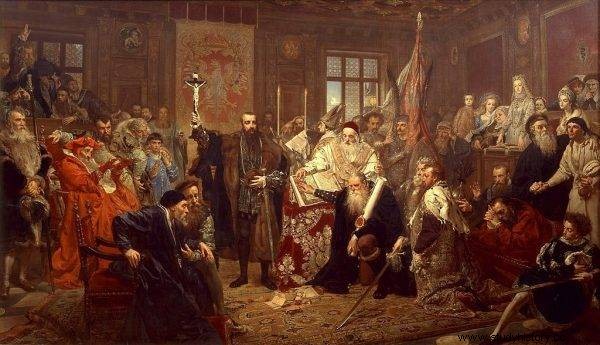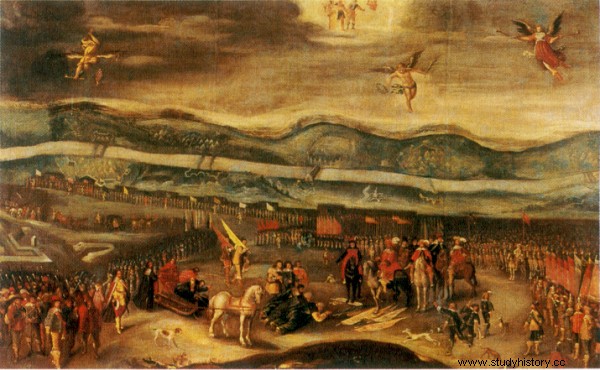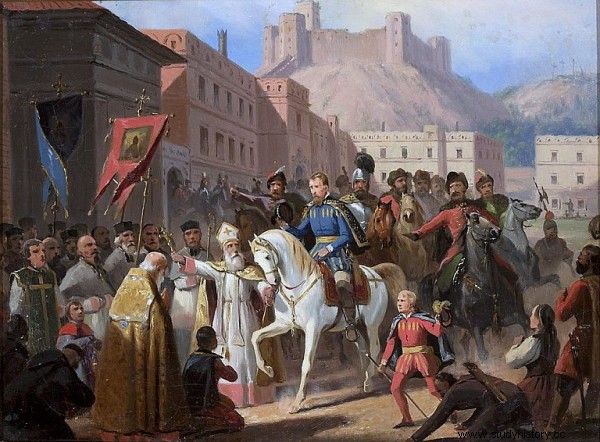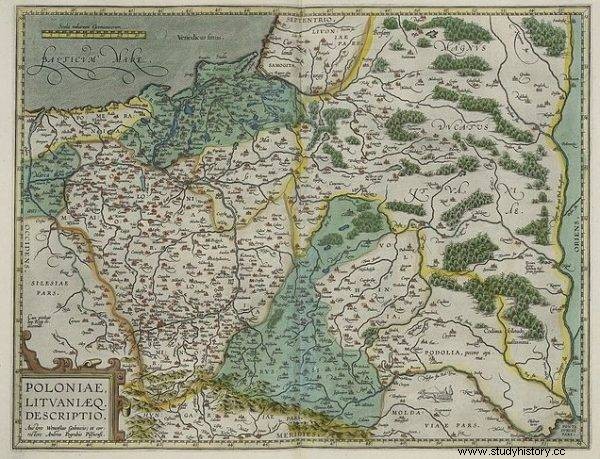It is said that Poland in the 17th century stretched "from sea to sea". It was then a real territorial power. But unfortunately it wasn't that strong in all respects.
Many readers are probably familiar with the statement that Poland stretched "from sea to sea". Our homeland had its "golden age". We were also a territorial power. But, unfortunately, our country, then already joint with the Grand Duchy of Lithuania, was not so strong in all aspects. Consider, for example, the population. There were also various internal problems.
When was Poland the greatest in its history?
As Aleksander Fredro once wrote, whom we associate rather with comedy works: Know that Poland consists of provinces as if from individual kingdoms It extends so far that if you were to stretch the rope from the outskirts of Lithuania, close to the Moscow border, to the foothills of the Carpathian Mountains, you would need a whole month to cover this distance. And on the other hand - count how long you would have to go from the mouth of the Dnieper to the Black Sea to the shores of the Baltic Sea . Thus, one would only need to know what cord our famous writer had in mind and at what speed he used to walk in order to clearly define the surface of Poland. Nothing easier, right?

The Union of Lublin established the Polish-Lithuanian Commonwealth, a state with a huge territory
Well, unfortunately not. Let us bear in mind that in those days there were no satellites able to see what we were holding in our hand. Exact mapping methods were not present. Therefore, even if we find information about the size of the territory of Poland in old sources, we should treat it with caution. These values are more or less approximate. The difference could be even including or not including territories somehow dependent on our country.
In statistical studies, 990,000 km 2 quite often appear in the context of the largest area of Poland which our state as the Polish-Lithuanian Commonwealth achieved in 1634 . Livonia was also included in this figure.
Great year 1634
What happened in 1634? Where exactly does this date come from in the sources? Various studies sometimes indicate an earlier date, i.e. the turn of 1618 and 1619, when the truce was concluded in Dywilinie. It ended the conflict of the Polish-Lithuanian Commonwealth with Moscow , during which there were even plans to place Prince Władysław (later Władysław IV Vasa) on the local throne. However, the truce will eventually expire, it may also be broken.

The peace treaty is a much more important act. And such was concluded in 1634 in Polanów
From the point of view of international law, a peace treaty is a much more important act. And such was concluded in 1634 in Polanów . It confirmed, inter alia, granting the Commonwealth to the lands of Smolensk, Chernihiv and Siewier. However, Władysław IV Waza had to forget about the Moscow crown. Let us also mention that just before the partitions, the area of Poland was already much smaller . It was then 733,000 km 2 .
Around the union of Lublin
Slightly more detailed data, including those on the "constituent parts" of Poland, are available in the sources for the time shortly after the union of Lublin. In 1580, the area of Poland was 865 or 867,000 km 2 . It included 5 provinces with the following area:
- Małopolska - 452 500 km 2 ;
- Grand Duchy of Lithuania - 297,000 km 2 ;
- Wielkopolska - 58,000 km 2 ;
- Mazowsze - 33 500 km 2 ;
- Royal Prussia - 24 or 26,000 km 2 .
The size of the Grand Duchy of Lithuania is remarkable. But! Remember that the principality was much bigger before . Only Zygmunt August came up with the idea to significantly reduce them. What for? That it would not put up such resistance in the context of negotiations regarding the planned conclusion of the Union of Lublin.
Territorial losses
What was that about? Zygmunt August, by decrees, included Podlasie and the Volhynia and Kiev regions of Bracław into Poland . It is worth knowing that when the Lithuanians broke off the negotiations, the representatives of these territories by no means left, claiming at the same time that they prefer to belong directly to Poland. And on the royal table there was even a plan of "incorporation privilege" in relation to the Grand Duchy of Lithuania itself ... Nevertheless, even without this moves of the king significantly weakened Lithuania territorially. But at the same time, they made the eastern problems less distant for Poland.

By decrees, Zygmunt August incorporated Podlasie and the Wołyńskie and Kiev voivodeships of Bracław into Poland.
How great were the territorial losses of Lithuania caused by the decisions of Sigismund Augustus? It can definitely be said that it is significant. The territory annexed in this way by Poland is approximately 312,800 km 2 and Lithuania alone was then only 297,000 km 2 . Which is less than half. Incidentally, the territory of our centuries-old ally was even greater in the past. Its area even reached 900,000 km 2 . Such a large Grand Duchy of Lithuania was still in the 15th century. The wars with Moscow and the territorial losses suffered reduced its area to approximately 550–520,000 km 2 .
On the other hand, this information also indicates the fact that if the Union of Lublin had taken place earlier, the joint Polish-Lithuanian state body would have an area exceeding one million km 2 . For example, in 1466 Poland alone had 260,000 km 2 .
Territorial power
We already know - at least approximately - the potentially record-breaking area of Poland. Now let's think:are these nearly a million square kilometers a lot or a little? Let us consider the second half of the 16th century, because again it is easier to find data here, even referring to those 867,000 km 2 . The European part of Russia was then 5,200,000 km 2 , it is also a gulf. Another country with a European and Asian part from that time was Turkey. The first one was then around 840,000 km 2 - we win! Of course, the situation would turn to our disadvantage, if the Asian part were also included. Next in line is Sweden counted together with Finland - 800,000 km 2 .
What about the usual European powers? These at that time were territorially far behind the Polish-Lithuanian Commonwealth . In the second half of the 16th century, Spain and Portugal are 580,000 km 2 , France - 450,000, and Germany even less - 410,000. The area of other European countries did not exceed 400,000 km then 2 . So in terms of surface area we really were a European power! After all - we were on the podium!
Population potential of Poland
However, this enormous area did not match the proportional population. This was especially true of the Grand Duchy of Lithuania. While in the area of Korona itself, the population density was 15 people per km 2 in the Grand Duchy of Lithuania this value was three times lower. How did we compare in this respect in comparison with other European countries?

The huge area of Poland in the 17th century did not match the proportionate population.
In 1650, the population of the Polish-Lithuanian Commonwealth was 11 million which gives a population density (in relation to the above-mentioned record area) about 11 people per km 2 . In the same year, the population of Germany is 10.3 million (ie comparable) , France - 18.8 million, Italy - 12.3. So we were definitely not a leader. Poland's situation worsens even more if we look at the population density:in Germany then it was 19 people / km 2 , in France as much as 35.1, and in Italy even more, i.e. 42.8. The question then arises, did we simply not have a territorially difficult-to-maintain over-area?
Multicultural Republic
In addition, of course, there was a great ethnic and religious diversity at the time. In the territory of the Polish-Lithuanian Commonwealth , apart from Poles and Lithuanians, of course, there were also Ukrainians, Germans, Jews, Tatars, Karaims, Wallachians, Armenians ... And, of course, our "Polish hell". Even under the last Jagiellons, it was not always peaceful in our country. Take, for example, all the confusion associated with the enforcement movement. But let's give the floor again to the famous author of Revenge :
Or when representatives of so many peoples who differ in different fates and types of property; and who do not have common families or ties of affinity, or, I ask:when their representatives come together at the Sejm, can they be revived by one common idea? Can they have the same advantages and disadvantages? (...) Therefore, in a republic of this type, the peoples who live in them do not have the same interests, the fear of danger does not share the same interests, and the aspirations to defend particular territories are not the same for them. When the inhabitants of Czernihowski are in danger, the inhabitant of Gdańsk Pomerania merely wants to acknowledge this fact and does not agree to burden himself with heavy burdens related to the defense of a distant voivodeship .
Unfortunately, Aleksander Fredro correctly diagnosed the greatest vices of the Commonwealth of that time . What this led to in the long run - no need to explain to anyone. As a nation, we should remember our "hellish" lessons from the past - and learn for the future. Sometimes we are our own enemy.
